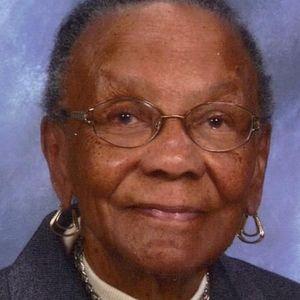In celebration of Black History Month, we will be highlighting stories of African American women who have uniquely contributed to the Smithsonian’s history. Check back on the blog throughout the month to explore the stories of these remarkable women.

She found the museum a fascinating place to work and would often study the museum’s exhibits on her lunch break. She did this because she enjoyed learning, but it also was useful in her job. There was no information desk in the museum in those years, so visitors would often ask her questions about what was on display. Mrs. Lutterlough set about to become what she called “a one-women information bureau.” She had graduated from Washington, D.C.’s elite Dunbar High School and had taken biology courses there, so she was especially interested in the natural history exhibits.
Mrs. Lutterlough also got to know the museum staff well as she took them to their work areas. One day she asked Dr. J. F. Gates Clark, an insect curator, if there was any work for her in the department he chaired, and so she was hired as an insect preparator in 1957. The museum had received an enormous collection of insects that needed to be cared for, so she was assigned to sort and prepare an enormous array of almost every type of insect in existence. She knew little about entomology, but was never daunted by the challenge. She consulted entomological textbooks and found pictures and descriptions to help her identify what she was looking at through her microscope. Occasionally she needed help, but worked hard to develop her own expertise.
 After two years she was appointed as Curator Ralph Crabill's research assistant, restoring and classifying Myriapoda, an insect group that contains over 13,000 species. The myriapods have myriad or many legs and include centipedes and millipedes. During her twenty-four years working with Crabill, Mrs. Lutterlough continued to increase her knowledge by reading entomology books, asking questions of specialists, and taking college courses in science, writing, and German to gain the skills needed for her position. She recalled that she enjoyed the challenges immensely. In 1965, for example, she tackled the F. C. Bishopp collection of ticks. Almost all of the specimens had become dried out, so she carefully treated some 35,000 ticks with a trisodium phosphate solution and then slowly added alcohol to restore them. She and Dr. Crabill also discovered some 40 type specimens mixed into the general collection that same year. When she retired in 1983, after forty years at the museum, she said her greatest challenge would now be “getting used to not coming to work at this wonderful institution.”
After two years she was appointed as Curator Ralph Crabill's research assistant, restoring and classifying Myriapoda, an insect group that contains over 13,000 species. The myriapods have myriad or many legs and include centipedes and millipedes. During her twenty-four years working with Crabill, Mrs. Lutterlough continued to increase her knowledge by reading entomology books, asking questions of specialists, and taking college courses in science, writing, and German to gain the skills needed for her position. She recalled that she enjoyed the challenges immensely. In 1965, for example, she tackled the F. C. Bishopp collection of ticks. Almost all of the specimens had become dried out, so she carefully treated some 35,000 ticks with a trisodium phosphate solution and then slowly added alcohol to restore them. She and Dr. Crabill also discovered some 40 type specimens mixed into the general collection that same year. When she retired in 1983, after forty years at the museum, she said her greatest challenge would now be “getting used to not coming to work at this wonderful institution.”
Related Collections
Accession 86-075 - Ralph E. Crabill Papers, 1950s-1970s, Smithsonian Institution Archives
Accession 86-077 - J. F. Gates (John Frederick Gates) Clarke Papers, 1951, Smithsonian Institution Archives
Produced by the Smithsonian Institution Archives. For copyright questions, please see the Terms of Use.

Leave a Comment